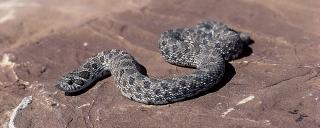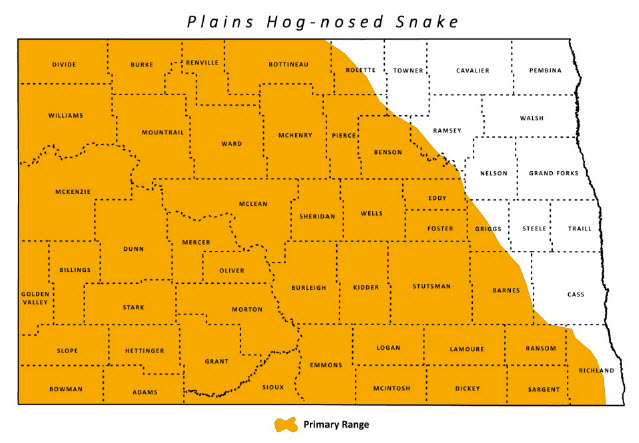
Plains Hog-nosed Snake
| Scientific Name | Heterodon nasicus |
|---|---|
| General Description | L 15-39”. Tan to yellowish-gray with dark blotches and a black belly with yellow or whitish squares. A unique upturned nose with keel on top sets this snake apart from the prairie rattlesnake. |
| Status | Year-round resident. |
| Abundance | Uncommon. |
| Primary Habitat | Dry grasslands with sandy or gravelly soil. |
| Federal Status | No federal status. |
| Reason for Designation | Listed as Vulnerable in Montana, Minnesota and Saskatchewan, and Imperiled in Manitoba by NatureServe. |
Locations and Conditions of Key Habitat
Preferred Habitat
Prefer dry, sandy or gravelly areas in grassland, open sand prairies, or sand dunes. Sometimes mixed forest habitats and cropland may be used. Burrow into the loose soil or may use mammal burrows for cover, but will not use artificial cover as much as other snakes. Most active in mornings and evenings, will estivate in very hot weather. Feed on a variety of prey such as toads, lizards, snakes, reptile eggs, small birds, and rodents, which they swallow whole and alive.
Key Areas and Conditions for Plains Hog-nosed Snake in North Dakota
No specific sites have been identified.
Problems Which May Affect this Species
Habitat
Sandy areas preferred by hog-nosed snakes are fragile habitats and may be easily degraded or destroyed.
Other Natural or Manmade Factors
Hog-nosed snakes may be intentionally killed if mistaken for a rattlesnake. It is unknown how pesticides, development, and other disturbance affect hog-nosed snakes.
Research and Survey Efforts
Current Research or Surveys
- North Dakota State University is currently surveying reptiles and amphibians in SE North Dakota.
Previous Research or Surveys
- University of North Dakota studied Climate Change and Land use Effects on Small Mammal Communities in a Northern Great Plans Landscape. This work included herptile surveys.
- Wheeler and Wheeler (1966) conducted a statewide survey of all amphibians and reptiles, as well as compiled existing records. The skinks were only found in the southeastern corner of the state.
- The REAP program (1978) found few records of the Smooth Green Snake in the southwest.
- Hoberg and Gause (1992) recorded personal observations of prairie skinks in North Dakota.
- A compilation of all records in North Dakota by Jundt (2000) listed roughly 35 documentations of the Plains Hog-nosed Snake in the state.
Additional Research or Surveys Needed
Future recommended survey methods would include trapping for this species.
Management Recommendations
- Maintain the open nature of habitat.
- Avoid excessive grazing and off-road vehicle use.
Monitoring Plans
Currently no monitoring is taking place. Possible monitoring options could include school classes/programs including universities, the general public through the NDGFD incidental reporting system, or national monitoring initiatives such as PARC. Monitoring should be directed at several species.
2005-2015 Progress
The Plains Hog-nosed Snake maintains a level I Species of Conservation Priority. More information is needed to understand the status of this species in North Dakota. Work toward a monitoring plan is needed.

Note: A listing of works consulted when compiling the information on this page may be found in the 2015 State Wildlife Action Plan.
